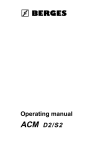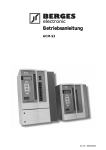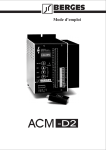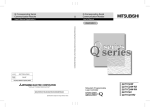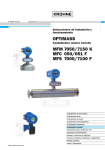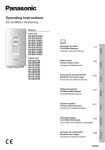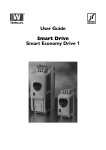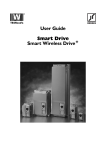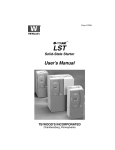Download Operating Instructions
Transcript
® BERGES Operating Instructions ACM-D2 Serial Data Transmission BERGES Protocol Translation based on document D2STDDI.DOC, revision 31.07.98. © 2003 BERGES electronic s.r.l. All rights reserved. Table of Contents 1 Introduction . . . . . . . . . . . . . . . . . . . . . . . . . . . . . . . . . . . . . . . . . . . . . . . . . . . . . . . . . . . . . . . . . . . . . . . . . . . 2 1.1 BERGES protocol . . . . . . . . . . . . . . . . . . . . . . . . . . . . . . . . . . . . . . . . . . . . . . . . . . . . . . . . . . . . . . . . 2 1.2 Extended BERGES protocol . . . . . . . . . . . . . . . . . . . . . . . . . . . . . . . . . . . . . . . . . . . . . . . . . . . . . . . . 2 1.3 ISO protocol . . . . . . . . . . . . . . . . . . . . . . . . . . . . . . . . . . . . . . . . . . . . . . . . . . . . . . . . . . . . . . . . . . . . . 2 2 General information about the BERGES protocol . . . . . . . . . . . . . . . . . . . . . . . . . . . . . . . . . . . . . . . . . . . . 2 3 Frame structure of the BERGES protocol (frame start byte = 99H) . . . . . . . . . . . . . . . . . . . . . . . . . . . . . . 3 4 Frame structure of the extended BERGES protocol (frame start byte = AAH) . . . . . . . . . . . . . . . . . . . . . 4 5 Protocol parameter manipulation . . . . . . . . . . . . . . . . . . . . . . . . . . . . . . . . . . . . . . . . . . . . . . . . . . . . . . . . . 4 5.1 CONTR byte. . . . . . . . . . . . . . . . . . . . . . . . . . . . . . . . . . . . . . . . . . . . . . . . . . . . . . . . . . . . . . . . . . . . . 4 5.2 INDEX byte . . . . . . . . . . . . . . . . . . . . . . . . . . . . . . . . . . . . . . . . . . . . . . . . . . . . . . . . . . . . . . . . . . . . . 5 5.3 Data format (data byte DAT-H, DAT-L) . . . . . . . . . . . . . . . . . . . . . . . . . . . . . . . . . . . . . . . . . . . . . . . . 5 6 Index list ACM-D2 (D2A-STD-014 software) . . . . . . . . . . . . . . . . . . . . . . . . . . . . . . . . . . . . . . . . . . . . . . . . . 5 7 Description of individual indexes . . . . . . . . . . . . . . . . . . . . . . . . . . . . . . . . . . . . . . . . . . . . . . . . . . . . . . . . . 7 8 7.1 Remark 1: range of ramp times (index 02...05) . . . . . . . . . . . . . . . . . . . . . . . . . . . . . . . . . . . . . . . . . . 7 7.2 Remark 2: reduction V/f braking phase (index 09). . . . . . . . . . . . . . . . . . . . . . . . . . . . . . . . . . . . . . . . 7 7.3 Remark 3: configuration of relay and open-collector outputs (index 0F...11). . . . . . . . . . . . . . . . . . . . 7 7.4 Remark 4: activation of external current threshold (index 12) . . . . . . . . . . . . . . . . . . . . . . . . . . . . . . . 8 7.5 Remark 5: motor current limit (index 19) . . . . . . . . . . . . . . . . . . . . . . . . . . . . . . . . . . . . . . . . . . . . . . . 8 7.6 Remark 6: current limit hysteresis (index 1A) . . . . . . . . . . . . . . . . . . . . . . . . . . . . . . . . . . . . . . . . . . . 8 7.7 Remark 7: rotation direction of fixed frequencies (index 1F) . . . . . . . . . . . . . . . . . . . . . . . . . . . . . . . . 9 7.8 Remark 8: setpoint input scaling (index 22) . . . . . . . . . . . . . . . . . . . . . . . . . . . . . . . . . . . . . . . . . . . . . 9 7.9 Remark 9a/9b: LEVELS (indexes 29 and 2A) . . . . . . . . . . . . . . . . . . . . . . . . . . . . . . . . . . . . . . . . . . . 9 7.10 Remark 10: extended parameterisation (index 2B) . . . . . . . . . . . . . . . . . . . . . . . . . . . . . . . . . . . . . . 10 7.11 Remark 11: output frequency display (index 2C) . . . . . . . . . . . . . . . . . . . . . . . . . . . . . . . . . . . . . . . . 10 7.12 Remark 12: motor voltage display (index 2D) . . . . . . . . . . . . . . . . . . . . . . . . . . . . . . . . . . . . . . . . . . 10 7.13 Remark 13: motor current display (index 2E). . . . . . . . . . . . . . . . . . . . . . . . . . . . . . . . . . . . . . . . . . . 11 7.14 Remark 14: keyboard & display (indexes 2F...32) . . . . . . . . . . . . . . . . . . . . . . . . . . . . . . . . . . . . . . . 11 7.15 Remark 15: software version (index 34) . . . . . . . . . . . . . . . . . . . . . . . . . . . . . . . . . . . . . . . . . . . . . . 12 7.16 Remark 16: SIO timeout (index 35) . . . . . . . . . . . . . . . . . . . . . . . . . . . . . . . . . . . . . . . . . . . . . . . . . . 12 7.17 Remark 17: error code (index 37) . . . . . . . . . . . . . . . . . . . . . . . . . . . . . . . . . . . . . . . . . . . . . . . . . . . 12 7.18 Remark 18: status word (index 38) . . . . . . . . . . . . . . . . . . . . . . . . . . . . . . . . . . . . . . . . . . . . . . . . . . 13 7.19 Remark 19: frequency setpoint (index 39) . . . . . . . . . . . . . . . . . . . . . . . . . . . . . . . . . . . . . . . . . . . . . 14 7.20 Remark 20: control word (index 3A). . . . . . . . . . . . . . . . . . . . . . . . . . . . . . . . . . . . . . . . . . . . . . . . . . 14 Examples . . . . . . . . . . . . . . . . . . . . . . . . . . . . . . . . . . . . . . . . . . . . . . . . . . . . . . . . . . . . . . . . . . . . . . . . . . . . 15 8.1 Setting the maximum frequency to 50.0 Hz (with slave reply) . . . . . . . . . . . . . . . . . . . . . . . . . . . . . . 15 8.2 Setting the frequency setpoint to 30.0 Hz (without slave reply) . . . . . . . . . . . . . . . . . . . . . . . . . . . . . 15 8.3 Output frequency display . . . . . . . . . . . . . . . . . . . . . . . . . . . . . . . . . . . . . . . . . . . . . . . . . . . . . . . . . . 16 8.4 Setting the setpoint reference to the Loc mode . . . . . . . . . . . . . . . . . . . . . . . . . . . . . . . . . . . . . . . . . 16 8.5 Example of a range violation (Fmax set to 655 Hz) . . . . . . . . . . . . . . . . . . . . . . . . . . . . . . . . . . . . . . 17 8.6 Example of CRC calculation . . . . . . . . . . . . . . . . . . . . . . . . . . . . . . . . . . . . . . . . . . . . . . . . . . . . . . . 17 12.03.03 Operating Instructions STDG1 Serial data transmission (BERGES protocol) 1 1 Introduction The D2A-STD software range supports independent serial data protocols over the serial interface. The inverter recognises the protocol automatically and so the user does not need to configure the protocol used. 1.1 BERGES protocol This protocol uses a block process with FEC (forward error correction) for error handling, thus enabling “secure” data transmission. Thanks to the compact structure of the data frame used and the simple protocol structure, the highest data transfer rate can be achieved with this protocol. Refer to the corresponding documents for further information about the BERGES protocol. The following text describes this protocol. 1.2 Extended BERGES protocol This has the same structure as the BERGES protocol, with the exception that inverter addresses up to the value 127 are accepted. 1.3 ISO protocol Refer to the corresponding documents for further information about the ISO protocol. 2 General information about the BERGES protocol A master/slave process is used. The master device is defined by its address (addr. = 0). All other devices are slave and so no arbitration mechanism is provided. Only the master device is allowed to start a transfer or polling. Slaves can communicate with one another via the master only (i.e.: during every transfer, the master must appear either as the sender or the recipient). It is possible to write all inverters (slaves) simultaneously from the master (address = 0) with the broadcast function (Write-Only). Thus, when changing Fmax to 60 Hz, for example, it is not necessary to singly address all inverters (slaves) with the corresponding address (SIO address set on the inverter) and the broadcast function can be used instead (Write-Only). The SIO addresses (SIO address > 0) of the inverters (slaves) cannot be adjusted with the broadcast function, except in the case of an inverter that has not yet been addressed (SIO address = 0) on the RS485 bus, which can be set to a still free address with the broadcast function. If an inverter is set to an address > 15 (extended BERGES protocol (frame start byte = AAH)), the address can also be adjusted with the BERGES protocol (frame start byte = 99H) via the broadcast function. The data is secured with a BLOCK CODE (line and column parities). In the receiving device, an FEC (forward error correction) process is used for error correction, and so simple errors can be corrected. Error bursts are also corrected provided they concern only one data byte. The data block affected is rejected if multiple errors are detected (this is not reported back!). TRANSFER: 2 1 start bit, 8 data bits, 1 stop bit, 9600 Baud e.g. Mode COM2: 9600, n, 8, 1. Operating Instructions 12.03.03 Serial data transmission (BERGES protocol) STDG1 Data transfer times 3 Frame structure of the BERGES protocol (frame start byte = 99H) STF BYTE0 Byte ADDR CONTR BYTE1 BYTE2 INDEX DAT-H BYTE3 BYTE4 Designation DAT-L BYTE5 CRC-R BYTE6 CRC-L BYTE7 Description BYTE0 STF Frame start byte: by virtue of this byte, the recipient recognises the required protocol and indicates the start of a data frame BYTE1 ADDR Address byte: SA: BIT7...BIT4: EA: BIT3...BIT0: Slave addresses: Slave address 0: BYTE2 CONTR Control byte BYTE3 INDEX Index byte BYTE4 DAT-H Data byte, high byte BYTE5 DAT-L Data byte, low byte BYTE6 CRC-R Column parity (even): the frame start byte (BYTE0) is not secured as well BYTE7 CRC-L Line parity (even): CRC-R is also taken into account Sender´s address Recipient´s address 1...15 no serial transfer 12.03.03 Operating Instructions STDG1 Serial data transmission (BERGES protocol) 3 4 Frame structure of the extended BERGES protocol (frame start byte = AAH) STF BYTE0 Byte 5 ADDR CONTR BYTE1 BYTE2 INDEX BYTE3 DAT-H BYTE4 Designation DAT-L BYTE5 CRC-R BYTE6 CRC-L BYTE7 Description BYTE0 STF Frame start byte: by virtue of this byte, the recipient recognises the required protocol and indicates the start of a data frame BYTE1 ADDR Address byte: SA: BIT7 = 1 EA: BIT7 = 0 BIT6...BIT0 = Slave addresses: Slave address 0: BYTE2 CONTR Control byte BYTE3 INDEX Index byte BYTE4 DAT-H Data byte, high byte BYTE5 DAT-L Data byte, low byte BYTE6 CRC-R Column parity (even): the frame start byte (BYTE0) is not secured as well BYTE7 CRC-L Line parity (even): CRC-R is also taken into account (to the master): Sender´s address (to the slave): Recipient´s address Slave address 1...127 no serial transfer Protocol parameter manipulation 5.1 CONTR byte The Contr byte serves to “switch over” the PROTOCOL for special applications, for polling and for protocol control (Write/Read). It is handled as follows: Contr byte = 00H Polling The slave addressed responds with the STATUS WORD (index 38) or with the ERROR CODE (index 37) if an error has occurred. Consequently, the polling block is also suitable for querying the inverter´s status. Contr byte, BIT7 Reply flag (read flag) The master requests a reply from the slave when a BIT7 is set. The slave replies only if explicitly requested to do so (BIT7 set). If a CONVERTER ERROR has occurred, it replies in any case with the ERROR CODE (index 37). The keyboard (index 2F to 32), which responds with the display content in any case, is an exception to this. If a slave responds with the BIT7 set, a protocol error is thus signalled to the master (e.g. a special application is not supported, range violations, attempt to write to read-only index, etc.). Contr byte, BIT0 change parameter (write flag) When set, BIT0 causes the slave to accept a parameter. A range check takes place in the slave. In the event of a range violation, an error flag is set (BIT7 in the next reply) and, depending on the index, the corresponding limit is accepted or the value is rejected. 4 Operating Instructions 12.03.03 Serial data transmission (BERGES protocol) STDG1 Contr byte, BIT1...BIT6 = 0 ACM-D2 1 x x x READ x x BIT6 BIT5 BIT4 BIT3 1 WRITE ACM-D2 BIT6...BIT1 = 0 BIT7 5.2 x BIT2 BIT1 BIT0 INDEX byte The index byte serves to specify the required parameter and the associated reply parameter (if a reply is requested). 5.3 Data format (data byte DAT-H, DAT-L) Data format: 16-bit integer unsigned (unless otherwise specified). DAT-H (high byte) DAT-L (low byte) BIT7 BIT6 BIT5 BIT4 BIT3 BIT2 BIT1 BIT0 BIT7 BIT6 BIT5 BIT4 BIT3 BIT2 BIT1 BIT0 6 Index list ACM-D2 (D2A-STD-014 software) Index 00 [1] Parameter Description Inverter value Index value Default 3 Maximum frequency 6...650 Hz 600...65000 5000 01 4 Minimum frequency 0...Fmax 0...Index 00 0 02 5 Startup time, ramp 1 0.05...1000 sec. Remark 1 (page 7) 03 6 Slow-down time, ramp 1 0.05...1000 sec. Remark 1 (page 7) 04 E Startup time, ramp 2 0.05...1000 sec. Remark 1 (page 7) 0.05...1000 sec. Remark 1 (page 7) 05 F Slow-down time, ramp 2 06 [1] 7 V/f ratio 30...650 Hz 3000...65000 5000 07 [1] 8 BOOST 0...40% 0...400 50 08 [1] 8+ Dynamic BOOST 0...50% 0...50 0 09 [1] 8- V/f reduction Braking phase 0...20% 100...80 Remark 2 (page 7) 80 0A [1] 9 Static torque 0...25 sec. 0...250 251 → continuous static torque 20 0B [1] t DC brake activation time 0...20 sec. 0...200 0 DC brake intensity 0...50% 0...50 15 0C [1] DC 0D [1] U Frequency threshold FX1 0...Fmax 0...Fmax 5000 0E [1] u Frequency threshold FX2 0...Fmax 0...Fmax 1000 0F REL Config. relay output -11...0...+11 Remark 3 (page 7) 10 OC1 Config. open-collector -11...0...+11 Remark 3 (page 7) 11 OC2 Config. open-collector -11...0...+11 Remark 3 (page 7) 12 S 0 = Loc/1 = Rem Remark 4 (page 8) 13 BrLim 0...15 0...15 0 0, 1, 2, 4, 6, 8 (0...5) 0...5 0 5...650 Hz 500...65000 5000 14 15 [1] Activ. current threshold, external Software braking protection DIS Display configuration Fm Final analog output value 12.03.03 Operating Instructions STDG1 Serial data transmission (BERGES protocol) 5 Index Parameter Description Inverter value Index value Default Setpoint input selection 1...5 0...4 0 16 REF 17 FILTER Digital filter 0...6 0...6 3 18 S - INT Handling of motor current limit 0...4 0...4 0 Limit: motor current 0...200% 0...255 Remark 5 (page 8) 150 Hysteresis: current limit 2...30% 3...39 Remark 6 (page 8) 4 Deceleration time: limit handling 0...20 sec. 0...200 50 19 [1] S 1A [1] HYS 1B [1] DY 1C [1] FFIX Fixed frequency 1 0...650 Hz 0...65000 500 1D [1] FFIX Fixed frequency 2 0...650 Hz 0...65000 1000 1E [1] FFIX Fixed frequency 3 0...650 Hz 0...65000 2000 1F FFIX Fixed-frequency rotation direction Remark 7 (page 9) 00000000 20 A. out Config. analog output 0...2 0...2 0 21 CLIP Clipping 0...15 0...15 2 40...100% 0...60 Remark 8 (page 9) 0 OFF, ON, Mpt1, Mpt2 (0...3) 0...3 0 0...100% 0...100 0 0 = linear/1 = quadrat. 0...1 0 22 [1] Fk Setpoint input scaling 23 JOG 24 AO Fine tuning: output frequency 25 JOG mode and motor potentiometer FFB Profile of V/f characteristic [1] FFB BOOST form factor 0...255 0...255 196 27 [1] MOD Modulation depth 0...255 0...255 ACM230V 230 ACM400V 245 28 R_Sel Activation of second ramp set 0...4 0...4 0 26 29 [1] Off LEVELS Remark 9a (page 9) 11111111 2A [1] Active LEVELS Remark 9b (page 9) 00000000 ON, OFF Remark 10 (page 10) 10111010 0...Fmax Remark 11 (page 10) 2B 2C SUB XPAR Extended parameterisation [1] 2D 2E 2F Output frequency display 2 Motor voltage display 0...100...x% Remark 12 (page 10) Read value I Motor current display 0...200% Remark 13 (page 11) Read value [1]...32 33 Keyboard & display Local/Remote SIO 34 35 1 Software [1] Remark 14 (page 11) 0...15 (BERGES protocol) A valid value is stored in non-volatile memory; the 0...127 values is ignored in the event of a range violation. (extended BERGES protocol) SIO address Software version Remark 15 (page 12) SIO Timeout Remark 16 (page 12) Read value 36 Reserved 37 Error code Remark 17 (page 12) Read value Status word Remark 18 (page 13) Read value 38 39 [1] Frequency setpoint 3A Control word 3B F Local 3C Reserved 3D Reserved 6 0...Fmax Remark 19 (page 14) Remark 20 (page 14) Value for internal works diagnosis Read value Operating Instructions 12.03.03 Serial data transmission (BERGES protocol) STDG1 Index Parameter 3E Description Inverter value Index value Default Reserved 3F Reserved 40 [1] a Locking freq. 1, low limit 0...650 Hz 0...Index 41 0 41 [1] A Locking freq. 1, high limit 0...650 Hz Index 40...Index 42 0 42 [1] b Locking freq. 2, low limit 0...650 Hz Index 41...Index 43 0 43 [1] B Locking freq. 2, high limit 0...650 Hz Index 42...Index 44 0 44 [1] c Locking freq. 3, low limit 0...650 Hz Index 43...Index 45 0 45 [1] C Locking freq. 3, high limit 0...650 Hz Index 44...Index 46 0 46 [1] d Locking freq. 4, low limit 0...650 Hz Index 45...Index 47 0 47 [1] D Locking freq. 4, high limit 0...650 Hz Index 46...65000 0 48 [1] s Compensation frequency 0...20 Hz 0...2000 0 49 [1] zero 4A [1] x Idle current 0...110 Frequency threshold compensation 0...110 0.5...30 Hz [2] 0 50...3000 50 [1] The index is set to its limit if the value range is violated. [2] With A5 A5, the momentary current is defined as the idle current. 7 Description of individual indexes 7.1 Remark 1: range of ramp times (index 02...05) All ramp times are defined via two indexes. The range and the time resolution are defined via the ramp code (DAT-H: BIT0 and BIT1). DAT-L contains the actual ramp value. The value is ignored in the event of range violations. 7.2 Ramp time in sec. DAT-H Ramp code DAT-L Index value 0.05...2.00 0 5...200 02.0...20.0 1 20...200 020...200 2 20...200 40 × 5...200 × 5 (200–1000) 3 40...200 Remark 2: reduction V/f braking phase (index 09) A value of 80 corresponds to a reduction of 20%. Conversion between index value and inverter value: [8–] = 100–index value Index value = 100–[8–] [8–] = reduction V/f braking phase in %. 7.3 Remark 3: configuration of relay and open-collector outputs (index 0F...11) The indexes 0F to 11 serve to configure the signalling outputs (relay, OC1, OC2). The index is supported as follows: 12.03.03 Operating Instructions STDG1 Serial data transmission (BERGES protocol) 7 DAT-H: 0 BIT7 0 BIT6 0 BIT5 0 BIT4 0 BIT3 0 BIT2 0 BIT1 0 BIT0 DAT-L: 0 BIT7 0 BIT6 0 BIT5 OC/Rel BIT4 OC/Rel BIT3 OC/Rel BIT2 OC/Rel BIT1 OC/Rel+– BIT0 OC/Rel contains the selection coding (value range: 0...11). The bit field OC/Rel+– contains the associated sign (0 → negative). The value is ignored in the event of range violations. 7.4 Remark 4: activation of external current threshold (index 12) The current threshold (index 19) can only be read out if this index is set to Rem. The current value is adopted if it is reset to Local. If data is written to this index in the Rem mode, the value is not adopted, but no protocol error is reported (BIT7 of the Contr byte is not set by the slave). The current Rem value is adopted if it is changed over to Loc. 7.5 Remark 5: motor current limit (index 19) A limit is set as a percentage of the inverter's rated current. The inverter's response to reaching of this limit can be set. Reaching of the limit can be signalled via the inverter's REL, OC1 and OC2 outputs. Conversion between index value and inverter value: Index value S[%] = ------------------------------ × 200 255 S[%] × 255 Index value = ----------------------------200 S = motor current limit in %. 7.6 Remark 6: current limit hysteresis (index 1A) The effective hysteresis of the motor current limit when ramp reduction is active is set with this index. This counteracts a tendency of the drive to oscillate. Conversion between index value and inverter value: Index value + 1 HYS[%] = ---------------------------------------2 Index value = ( 2 × HYS[%] ) – 1 HYS = current limit hysteresis in %. 8 Operating Instructions 12.03.03 Serial data transmission (BERGES protocol) STDG1 7.7 Remark 7: rotation direction of fixed frequencies (index 1F) DAT-H: 0 BIT7 0 BIT6 0 BIT5 0 0 BIT4 BIT3 0 0 BIT2 0 BIT1 BIT0 DAT-L: 0 BIT7 7.8 0 BIT6 Fix3_V BIT5 Fix3_KL Fix2_V BIT4 BIT3 Fix2_KL BIT2 Fix1_V BIT1 Fix1...3_V = 1 Clockwise rotation Fix1...3_V = 0 Counterclockwise rotation Fix1...3_KL = 1 Rotation depending on the control input (terminal 15) Fix1...3_KL = 0 Rotation depending on the setting of Fix1...3_V Fix1_KL BIT0 Remark 8: setpoint input scaling (index 22) The reference signal can be scaled via this index. The programmed final values of the output frequency range are reached at the percentage of the final scale values entered by means of Fk. Conversion between index value and inverter value: Fk = 100 – Index value Index value = 100 – Fk Fk = scaling in %. 7.9 Remark 9a/9b: LEVELS (indexes 29 and 2A) These indexes serve to configure the digital control inputs. 0 (Remote); the corresponding function is controlled via the serial interface 1 (Local); the corresponding function is controlled via the digital control input (terminal) Index 29 = 1; setting the logic level of the corresponding digital control input (high or low-active) Index 29 = 0; Activates (1) or deactivates (0) the corresponding function via the serial interface 29 (OffLEVEL) 2A (ActivLEVEL) Description Index 2A (ActivLEVEL) Index 29 (OffLEVEL) BIT7 Terminal 30 0 1 BIT6 Terminal 26 0 1 BIT5 Terminal 25 0 1 BIT4 Terminal 24 0 1 BIT3 Terminal 23 0 1 12.03.03 Operating Instructions STDG1 Serial data transmission (BERGES protocol) 9 Description Index 2A (ActivLEVEL) Index 29 (OffLEVEL) BIT2 Terminal 16 0 1 BIT1 Terminal 15 0 1 BIT0 Terminal 11 0 1 NOTE: The “active” logic/OffLEVELS are modified, not the ones that can be modified on the keyboard. Therefore, the keyboard values become active again when the inverter is restarted. This avoids inadmissible terminal configurations (e.g. inactive lock) when starting the inverter. 7.10 Remark 10: extended parameterisation (index 2B) The index 2B (SW1...SW8) is handled as follows: DAT-L Description Range Default BIT7 DC brake ON (1), OFF (0) 1 (ON) BIT6 Config. of inputs START/STOP and REVERSING ON (1), OFF (0) 0 (OFF) BIT5 Config. of error reset ON (1), OFF (0) 1 (ON) BIT4 Fmin operation ON (1), OFF (0) 1 (ON) BIT3 Config. of error signalling relay ON (1), OFF (0) 1 (ON) BIT2 DC brake frequency trigger ON (1), OFF (0) 0 (OFF) BIT1 Config. of Autostart function ON (1), OFF (0) 1 (ON) BIT0 Activation of “S” ramp ON (1), OFF (0) 0 (OFF) NOTE: The value is ignored in the event of range violations. 7.11 Remark 11: output frequency display (index 2C) The index 2C serves to query the inverter's output frequency. When data is written to this index, the setpoint frequency is modified (changeover of the setpoint reference to remote operation). The setpoint reference can be reset to the local mode via the CONTROL WORD (index = 3A). 7.12 Remark 12: motor voltage display (index 2D) MOD 0...255 ACM 230V: 230 / ACM 400V: 245 When the depth of modulation parameter MOD (index 27) is left set to the default, this results is a range of 0...100% for the voltage display. The actual value then covers a range (for 0...100% of the maximum voltage) of 0...230 (230 V unit) or 0...245 (400 V unit). If the depth of modulation is modified, the result is an index value of 0 to depth of modulation. However, the percentage shown in the inverter display (and thus the voltage in %) always refers to the value specified for the respective inverter (230 V unit: 230/400 V unit: 245). Apart from a certain amount of saturation in the dc link circuit, you can calculated with the following linear formulas: Conversion between index value and inverter value: 10 Operating Instructions 12.03.03 Serial data transmission (BERGES protocol) STDG1 Index value 230 V unit: U[%] = ------------------------------ × 100 230 Index value 400 V unit: U[%] = ------------------------------ × 100 245 U = motor voltage in %. A depth of modulation that has been set to a value above the default results in percentages above 100. 7.13 Remark 13: motor current display (index 2E) The motor current is display in the range from 0...200% of the unit's rated current. Conversion between index value and inverter value: Index value I[%] = ------------------------------ × 200 255 I[%] × 255 Index value = -------------------------200 I = motor current in %. 7.14 Remark 14: keyboard & display (indexes 2F...32) The indexes 2F to 32 serve to remotely control the keyboard via the serial interface and to query the display's content. This permits remote control via the inverter's menu structure. Write access to this index results in switching over of the keyboard to the remote mode. Read access switches the keyboard back to the local mode. In the event of range violations, the value is ignored and the keyboard is switched to the local mode. for safety reasons, only the SIO address of the inverter cannot be modified via the indexes 2F to 32. The terminal configuration can also be sent. In this case, BIT0 of the DAT-L byte is set to one. Contrary to what is otherwise generally usual, the response to an inverter error is not an ERROR CODE. Reply frames depending on the requested index: INDEX DAT-H DAT-L 2F Digit 1 Digit 2 30 Digit 3 Digit 4 31 Digit 5 Digit 6 32 Digit 7 Digit 8 Remote keyboard operation and terminal configuration are supported as follows: DAT-H DAT-L BIT7 Terminal 30 SHIFT key BIT6 Terminal 26 DEC key BIT5 Terminal 25 INC key BIT4 Terminal 24 SELECT key BIT3 Terminal 23 BIT2 Terminal 16 BIT1 Terminal 15 BIT0 Terminal 11 12.03.03 Operating Instructions STDG1 Serial data transmission (BERGES protocol) (DAT-H: terminals “No/Yes”) 11 If BIT0 of the DAT-L byte is a one, the protocol interprets DAT-H as transfer of the “master terminal states”. However, remotely controlled terminal must first be “disconnected” from the inverter's terminal panel with the aid of index 29. 7.15 Remark 15: software version (index 34) This is a read-only index that provides information about the inverter software in use. DATH contains the code for the software type, while DAT-L contains the current software version. 7.16 Remark 16: SIO timeout (index 35) The timeout serves to intercept uncontrolled inverter states as might be possible in the event of an interruption in the RS485 connection: If BIT7 in the DAT-L byte is zero, after the timeout has elapsed the inverter is shut down to 0 via the slow down ramp and the states for the display, keyboard, setpoint and terminals are reset to the local mode. “Time Out” appears on the display until the inverter is once again addressed via the serial interface or the device is switched off and then switched on again. The timeout range is from 0...127, a value of 1...127 corresponding to a timeout of 0.1...12.7 sec. Timeout monitoring is stopped if the value 0 is passed on. The SIO timeout index also supports shutdown of an RS485 connection. BIT7 in the DATL byte must be set. Bits 0...6 in the DAT-L byte (0...127) reflect the timeout time. After the timeout has elapsed, only the states for the display, keyboard, setpoint and terminals are reset to the local mode. 7.17 Remark 17: error code (index 37) DAT-H contains the error flag, and so it reports occurring errors or faults. It must be reset via the terminals or the terminals controlled with the index 2A. DAT-H Error flag BIT7 Deactivation due to excess current (OVERLOAD) BIT6 Deactivation due to excess inverter temperature (OVERTEMP) BIT5 Deactivation due to excess voltage (OVERVOLT) BIT4 BIT3 Deactivation due to excess motor temperature (OT_MOTOR) BIT2 BIT1 BIT0 BIT0...BIT7 = 1 Fatal error (reset only by inverter POWER-UP) DAT-L contains the warning flag, which informs about pending warnings. There is no need to reset it. BIT0: 12 0 = BIT1...BIT7; warning flag 1 = BIT1...BIT3; extended warning flag Operating Instructions 12.03.03 Serial data transmission (BERGES protocol) STDG1 DAT-L Warning flag (BIT0 = 0) BIT7 Deactivation due to undervoltage (UNDERVOL) BIT6 Type-specific current limit reached (overload) BIT5 Undervoltage value briefly reached (undervol) BIT4 Set current limit reached; ramp stop (RAMP) BIT3 Set current limit reached; output frequency reduction (HYST) BIT2 Set current limit reached; inverter stop (ILIMIT) BIT1 Setpoint line discontinuity or setpoint less than 4mA (I < 4 mA) BIT0 If BIT0 = 1, see extended warning DAT-L Extended warning flag (BIT0 = 1) BIT3 BIT2 BIT1 0 0 0 JOG mode active (JOG) 0 0 1 Dynamic brake active (Dyn Brake) 0 1 0 Limit of software brake protection circuit close (br_limit) 0 1 1 Software brake protection limit exceeded (BR_LIMIT) 1 0 0 Motor potentiometer function: fixed frequency with wrong direction of rotation (MPtFault) 1 0 1 Maximum permitted inverter operating temperature reached (overtemp) 1 1 0 Maximum permitted motor operating temperature reached (ot_motor) 9...127 7.18 Reserved Remark 18: status word (index 38) The status word provided information about the inverter's operating state. Only read access to the status word is possible. DAT-H OUTPORT (Read-Only) BIT7 BIT6 BIT5 BIT4 Open-Collector 2 BIT3 Open-Collector 1 BIT2 Relay output (terminals 19, 20) BIT1 Error signalling relay (terminals 122,123,124) BIT0 Enabling 12.03.03 Operating Instructions STDG1 Serial data transmission (BERGES protocol) 13 DAT-L Control flag (Read-Only) BIT7 Direction of rotation (R=1 L=0) BIT6 Blind version (terminal board with LED monitoring) BIT5 Reserved for version with optional hardware (additional RAM) BIT4 Inverter stopped (STOP) BIT3 DC brake activated (DC STOP) BIT2 7.19 BIT1 Ramp (BIT 0-1) “11” → rises; “01” → drops BIT0 Ramp (BIT 0-1) “00” → stopped/reached Remark 19: frequency setpoint (index 39) A write operation to this index results in automatic changeover of the setpoint reference to the remote mode, while a read operation switches to the local mode. The value range is limited at Fmax. A range violation leads to an error message. In this case, the set frequency is limited at Fmax. 7.20 Remark 20: control word (index 3A) The control word serves to switch the inverter to various device states. However, the majority of inverter control is already covered by the index 2A (LEVELS), which is available for “terminal-oriented” operation of the device. The remaining necessary control actions can be implemented via the control word. The value is ignored in the event of range violations. DAT-H BIT7 BIT6 BIT5 BIT4 BIT3 BIT2 BIT1 BIT0 DAT-L BIT7 Setpoint Loc (“0”) / Rem (“1”) BIT6 Keyboard Loc (“0”) / Rem (“1”) BIT5 Display Loc (“0”) / Rem (“1”) BIT4 BIT3 BIT2 0 = control bits 3...7 can be manipulated 1 = save parameter (control bits 3...7 = 0) BIT1 2 = I_LOAD (control bits 3...7 = 0) 3 = I_SAVE (control bits 3...7 = 0) BIT0 4 = error + timer reset (control bits 3...7 = 0) 14 Operating Instructions 12.03.03 Serial data transmission (BERGES protocol) STDG1 8 Examples How to handle the BERGES protocol will be demonstrated with reference to a few examples. The inverter with the address 1 is to be addressed. Its maximum frequency ought to be set first to 50.0 Hz. Then specify the inverter setpoint frequency as 30.0 Hz. If the output stages are enabled, the inverter runs on the ramp to 30.0 Hz. The inverter frequency ought to be queried in a further step. Finally, the setpoint reference ought to be reset to the Loc mode. The inverter now once again uses the common ADC value as the setpoint reference. 8.1 Setting the maximum frequency to 50.0 Hz (with slave reply) Refer to the index list (page 5) for the following line: Index Parameter Description Inverter value Index value Default 3 Maximum frequency 6...650 Hz 600...65000 5000 00 The index for the maximum frequency parameter is 00H. The permissible frequency range here from 6 to 650 Hz corresponds to an index value from 600 to 65000 that is to be sent. This is equivalent to a factor of 100 in the conversion. Therefore, a value of 5000 (1388H) must be sent. The associated protocol is as follows: Master (Write/Read) STF ADDR CONTR INDEX DAT-H DAT-L CRC-R CRC-L 99H 01H 81H 00H 13H 88H 1BH 09H Master (Write/Read) (Extended BERGES protocol) STF ADDR CONTR INDEX DAT-H DAT-L CRC-R CRC-L AAH 01H 81H 00H 13H 88H 1BH 09H STF ADDR CONTR INDEX DAT-H DAT-L CRC-R CRC-L 99H 10H 01H 00H 13H 88H 8AH 2BH Slave (reply) Slave (reply) (Extended BERGES protocol) 8.2 STF ADDR CONTR INDEX DAT-H DAT-L CRC-R CRC-L AAH 81H 01H 00H 13H 88H 1BH 0AH Setting the frequency setpoint to 30.0 Hz (without slave reply) Here, the method is the same as when setting the maximum frequency. Refer to the index list (page 5) for details of the value (DAT-H, DAT-L) of the index 39H. To set 30.0 Hz, you must send a value of 3000 (BB8H). The associated protocol is as follows: 12.03.03 Operating Instructions STDG1 Serial data transmission (BERGES protocol) 15 Master (Write-Only) 8.3 STF ADDR CONTR INDEX DAT-H DAT-L CRC-R CRC-L 99H 01H 01H 39H 0BH B8H 8AH 2BH Output frequency display Refer to the index list (page 5) for details of the value (DAT-H, DAT-L) of the index 2CH. The associated protocol is as follows: Master (Read-Only) STF ADDR CONTR INDEX DAT-H DAT-L CRC-R CRC-L 99H 01H 80H 2CH 00H 00H ADH 27H Master (Read-Only) (Extended BERGES protocol) STF ADDR CONTR INDEX DAT-H DAT-L CRC-R CRC-L AAH 01H 80H 2CH 00H 00H ADH 27H STF ADDR CONTR INDEX DAT-H DAT-L CRC-R CRC-L 99H 10H 00H 2CH 0BH B8H 8FH 2DH Slave Slave (Extended BERGES protocol) 8.4 STF ADDR CONTR INDEX DAT-H DAT-L CRC-R CRC-L AAH 81H 00H 2CH 0BH B8H 1BH 0CH Setting the setpoint reference to the Loc mode The setpoint reference can be set with the CONTROL WORD (see remark 20 on page 14). The index of the control word is 3AH, and the index value (DAT-H, DAT-L) must amount to 00H. The associated protocol is as follows: Master (Write/Read) STF ADDR CONTR INDEX DAT-H DAT-L CRC-R CRC-L 99H 01H 81H 3AH 00H 00H BAH 21H Master (Write/Read) (Extended BERGES protocol) 16 STF ADDR CONTR INDEX DAT-H DAT-L CRC-R CRC-L AAH 01H 81H 3AH 00H 00H BAH 21H Operating Instructions 12.03.03 Serial data transmission (BERGES protocol) STDG1 Slave STF ADDR CONTR INDEX DAT-H DAT-L CRC-R CRC-L 99H 10H 01H 3AH 00H 00H 2BH 03H Slave (Extended BERGES protocol) 8.5 STF ADDR CONTR INDEX DAT-H DAT-L CRC-R CRC-L AAH 81H 01H 3AH 00H 00H BAH 22H Example of a range violation (Fmax set to 655 Hz) The index for the maximum frequency parameter is 00H. Therefore, the frequency range permissible here from 6 to 650 Hz is exceeded by 5 Hz. Therefore, a value of 65500 (= FFDCH) must be sent. If the range is violated, in this case the maximum range (650 Hz) must be adopted and the BIT7 must be set in the Contr byte of the slave reply. The associated protocol is as follows: Master (Write/Read) STF ADDR CONTR INDEX DAT-H DAT-L CRC-R CRC-L 99H 01H 81H 00H FFH DCH A3H 11H Master (Write/Read) (Extended BERGES protocol) STF ADDR CONTR INDEX DAT-H DAT-L CRC-R CRC-L AAH 01H 81H 00H FFH DCH A3H 11H STF ADDR CONTR INDEX DAT-H DAT-L CRC-R CRC-L 99H 10H 81H 00H FDH E8H 84H 09H Slave Range violation Max. limit range (650 Hz – Fmax ACM-D2) Slave (Extended BERGES protocol) STF ADDR CONTR INDEX DAT-H DAT-L CRC-R CRC-L AAH 81H 81H 00H FDH E8H 15H 28H Range violation 8.6 Max. limit range (650 Hz – Fmax ACM-D2) Example of CRC calculation STF ADDR CONTR INDEX DAT-H DAT-L CRC-R CRC-L 99H 01H 81H 00H 13H 88H 1BH 09H BYTE0 BYTE1 BYTE2 BYTE3 BYTE4 BYTE5 BYTE6 BYTE7 12.03.03 Operating Instructions STDG1 Serial data transmission (BERGES protocol) 17 1 0 0 1 1 0 0 1 Column BYTE0 Row ADDR 0 0 0 0 0 0 0 1 1 BYTE1 CONTR 1 0 0 0 0 0 0 1 0 BYTE2 INDEX 0 0 0 0 0 0 0 0 0 BYTE3 DAT-H 0 0 0 1 0 0 1 1 1 BYTE4 DAT-L 1 0 0 0 1 0 0 0 0 BYTE5 CRC-R 0 0 0 1 1 0 1 1 0 BYTE6 CRC-L 0 0 0 0 1 0 0 1 BYTE7 Always “0” EVEN parity is always used: 18 CRC-R: The total number of “1” in a byte and the associated bit in CRC-R must be even; so, if the byte contains an odd number of “1”, the associated bit in CRCR must be “1”. The bit in CRC-R is equal to “0” if the number of “1” is even. CRC-L: Must be generated in the same way as CRC-R, but via the rows. CRC-R is always also considered. The first two bits are always “0”. Operating Instructions 12.03.03 Serial data transmission (BERGES protocol) STDG1 ® BERGES Berges electronic s.r.l. Zona industriale, 11 I–39025 Naturno Italy Tel. +39 (0)473 671911 Fax +39 (0)473 671909 http://www.berges.it [email protected] Uff. vendite Milano Via Monteverdi, 16 I–20090 Trezzano sul Naviglio (MI) Tel. +39 (0)2 48464206 Fax +39 (0)2 48499911 Berges electronic GmbH Industriestraße 13 D–51709 Marienheide-Rodt Postfach 1140 • D–51703 Marienheide Tel. +49 (0)2264 17-0 Fax +49 (0)2264 17126 http://www.berges.de [email protected] TB Wood’s Incorporated 440 North Fifth Avenue Chambersburg, Pennsylvania 17201-1778 Telephone: 888-TBWOODS or 717-264-7161 Fax: 717-264-6420 http://www.tbwoods.com [email protected]






















